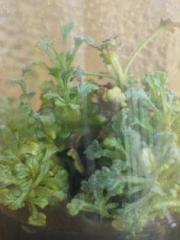Search the Community
Showing results for tags 'taxonomy'.
Found 4 results
-

How expensive is DNA sequencing for plants?
mu! posted a topic in Pharmacology, Chemistry & Medicine
Often in the plant community you'll find yourself in a discussion (often around cacti) involving naming and identification of various plants. The arc of the discussion usually starts with crude estimating at what a particular clone a plant is, then comes refining of the 'model' that makes up the characteristics of said plant, and from there any further discussion disintegrates into pseudo-scientific ambiguity. Sometimes (if you're lucky!) the topic of DNA sequencing is used to short-circuit the downward spiral into taxonomic hell: "well, we can only really know which plant is which once they've been sequenced." Why the hell isn't this DNA sequencing happening so we can stop wasting all this precious oxygen on arguments around "what is a macrogonus", or "this is what a pachanoid looks like"? Is it really so prohibitively expensive that nobody has taken it upon themselves to send some samples into a lab to get sequenced? Am I trivialises/generalises how difficult it actually is to do the DNA sequencing of a plant? I am genuinely curious. What are the practical barriers to getting, say, the Trichocereus genus (yes im sticking to old nomenclature) sequenced so we can settle the argument once and for all when it comes to identification? Imagine that this genus has already been sequenced, how would laypeople in the plant community then use this information to correctly identify their plants?- 24 replies
-
- 4
-

-
- taxonomy
- dna sequencing
-
(and 1 more)
Tagged with:
-
This is gorgeous. Well written and beautifully illustrated. Local. And free. Fits nicely on portable devices Whoever funded this really got their money's worth A guide to common fungi of the Hunter-Central Rivers region http://hunter.lls.nsw.gov.au/__data/assets/pdf_file/0009/516807/guide-to-common-fungi-hcr.pdf
-
In an attempt to apologize for my last thread with a similar title I am reposting this information, only this time without the psychobabble and craziness. Last semester I had an upper level plant taxonomy class, which required us to write a very large term paper and an oral presentation on a plant family of our choosing. I chose the genus Trichocereus/Echinopsis. I did not conduct any of the physical investigation in this field, however I sourced, read, compared, and evaluated numerous texts on the subject. The end result was compiled into a 20 page paper titled "termpaperroughdraftupdate.doc" and a power point presentation titled "presentation.ppt". For those of you who do not have access to powerpoint I also included "presentation.pdf", but you lose some of the slide transitions. Most notably the flower morphology slide is all garbled in the pdf version. I have uploaded all of these files (some separately) as a large zip file. It contains all of my sourced articles, however I did remove trout's notes on San Pedro out of respect for a great member here. Please note that some of the journal articles may not have the most informative file names, because I didn't bother going back to change them after saving them for my personal use. I hope that you will find the information interesting and useful. The powerpoint presentation offers the most condensed and easy to follow form of the material. However for those of you interested in such matters I feel that the research paper also offers a plethora of information you may or may not have known about. You can download the zip file at: https://dl.dropboxusercontent.com/u/57030275/Archive.zip I also uploaded 2 other documents that I used to help me study for the class. One discusses some terms used in botany, the other discusses some plant family systematics. https://dl.dropboxusercontent.com/u/57030275/definitions.pdf https://dl.dropboxusercontent.com/u/57030275/Plant%20family%20systematics.pdf If you prefer individual files instead or if you missed the craziness and have a desire to see it, check out my thread in the bitches, gripes and degenerate threads forum: http://www.shaman-australis.com/forum/index.php?showtopic=37313&p=450789 http://www.shaman-australis.com/forum/index.php?showtopic=37313&p=450674 Additionally, if you would like to listen to some good tunes while mulling over this information, please check out Mc. Yogi: https://soundcloud.com/mc-yogi/be-the-change-earthrise Works Referenced Journal Articles: Anceschi, G., Magli, A. 2013. The new monophyletic macrogenus Echinopsis. No risk of paraphyly, and the most convincing hypothesis in phylogenetic terms. Cactaceae Systematics Initiatives 31: 24-27. Albesiano S., Terrazas T. 2012. Cladistic Analysis of Trichocereus (Cactaceae: Cactoideae:Trichocereeae) Based on Morphological Data and Chloroplast Dna Sequences. Haseltonia 17: 3-23. Albesiano S., Terrazas T. 2012. A New Taxonomic Treatment of the Genus Trichocereus (Cactaceae) in Chile. Haseltonia, 18: 116-139. Arakaki M., Christin P. A, et. al. 2011. Contemporaneous and recent radiations of the world’s major succulent plant lineages. Proceedings of the National Academy of Sciences, USA 108: 8379–8384. Buxbaum F. 1958. The phylogenetic division of the sub- family Cereoideae, Cactaceae. Madroño 14: 177−206. Bárcenas R, Chris Yesson C, Hawkins J. A. 2011. Molecular systematics of the Cactaceae. Cladistics 27: 470–489. Downie S.R, Palmer J.D. 1994. A chloroplast DNA phylogeny of the Caryophyllales based on structural and inverted repeat restriction site variation. Systematic Botany 19: 236–252. Friedrich, H. 1974. Zur Taxonomie und Phylogenie der Echinopsidinae (Trichocereinae). IOS-Bulletin 3: 79–93. Friedrich H. and Glatzel W. 1983. Seed morphology as an aid to classifying the genus Echinopsis Zucc. Bradleya 1: 91–104. Hernández T., Hernández H.M., et. al. 2011. Phylogenetic relation- ships and evolution of growth form in Cactaceae (Caryophyllales, Eudicotyledoneae). American Journal of Botany 98: 44–61. Kiesling R. 1978. El género Trichocereus (Cactaceae) I: Las especies de la Rep. Argentina. Darwiniana 21: 263−330. Korotkova N., Zabel L. , D. Quandt, and W. Barthlott. 2010. A phylogenetic analysis of Pfeiffera and the reinstatement of Lymanbensonia as an independently evolved lineage of epiphytic Cactaceae within a new tribe Lymanbensonieae. Willdenowia 40: 151–172. Metzing D., Kiesling R. 2008. The Study Of Cactus Evolution: The Pre-DNA Era. Haseltonia 14: 6-25. Nyffler R., Eggli U., 2010. A farewell to dated ideas and concepts - Molecular phylogenetics and a revised suprageneric classification of the family Cactaceae. Schumannia 6: 109–149. Ritter F. 1980a. Kakteen Südamerika 2. Argentinien/Bo- livien. Germany. Ritter F. 1980b. Kakteen Südamerika 3. Chile. Germany. Ritter F. 1981. Kakteen Südamerika 4. Peru. Germany. Ritz, C.M., Martins L., et al. 2007. The molecular phylogeny of Rebutia (Cactaceae) and its allies demonstrates the influence of paleogeography on the evolution of South American mountain cacti. American Journal of Botany 94: 1321–1332. Rowley, G.D. 1974. Reunion of the genus Echinopsis. A preface to nomenclatural revisions. IOS Bulletin 3: 93–99. Schick R. 2011. Echinopsis sensu stricto and Trichocereus: Differentiating the Genera. Cactus and Succulent Journal 83: 248-255. Schlumpberger B.O., Renner S.S., 2012. Molecular Phylogenetics of Echinopsis (Cactacea): Polyphyly at all Levels and Convergent Evolution of Pollinator Modes and Growth Forms. Books: Anderson, E. F. 2001. The cactus family. Timber Press, Portland, Oregon, USA. Anderson, E. F. 2005. Das große Kakteen-Lexikon. Eugen Ulmer, Stuttgart, Germany. Backeberg C. 1959. Die Cactaceae 2. Gustav Fischer Verlag, Jena. Barthlott, W., Hunt, D., 1993. Cactaceae. The Families and Genera of Vascular Plants, Vol. II. Springer Verlag, Berlin, pp. 161–197. Britton NL, Rose JN. 1920. The Cactaceae: Descriptions and illustrations of plants of the cactus family. Vol. 2. Carnegie Institution, Washington. Cronquist A., Thorne R. F. 1994. Nomenclatural and taxonomic history. Caryophyllales: Evolution and Systematics 87-121. Springer, Berlin. Gibson, A.C., Nobel P.S. 1986. The cactus primer. Cambridge, Mass.: Harvard University Press. Hillis, D. M. 2012. Principles of life. Sunderland, MA: Sinauer Associates Hunt, David et al. 2006. The New Cactus Lexicon, DH Books, the Manse, Chapel Lane, Milborne, England. Nobel, Park S. 2002. Cacti biology and uses. Berkeley: University of California Press. Trout, K. 1999. Trout's notes on sacred cacti: botany, chemistry, cultivation & utilization (including notes on some other succulents). 2 ed. Austin, TX: Better Days Pub. Websites: "tassonomia | cactusinhabitat." tassonomia | cactusinhabitat. N.p., n.d. Web. 11 Dec. 2013. <http://www.cactusinhabitat.org/index.php?p=tassonomia&l=en>. Other: The Cactus Explorer’s club, 2013. The Cactus Explorer 8. Briars Bank, Fosters Bridge, Ketton, Stamford PE9 3BF U.K. Olabode Olufunmilayo Ogunbodede 2009. Alkaloid Content in Relation to Ethnobotanical use of Trichocereus Pachanoi and Related Taxa. A Thesis Presented to the School of Arts and Sciences Sul Ross State University (some may or not may be used in this list this was an initial investigation) Albesiano S., 2012. A New Taxonomic Treatment of the Genus Trichocereus (Cactaceae) in Chile. Haseltonia: Vol. 18, pp. 116-139. Albesiano S., Terrazas T., 2012. Cladistic Analysis of Trichocereus (Cactaceae: Cactoideae: Trichocereeae) Based on Morphological Data and Chloroplast DNA Sequences. Haseltonia: Vol. 17, pp. 3-23. Alonso-Pedano M., Ortega-Baes P., 2012. Generalized and complementary pollination system in the Andean cactus Echinopsis schickendantzii. Plant Syst Evol: Vol. 298, pp. 1671-1677. Barcenasa R. T, Yessonb C. Hawkinsb J. A., 2011. Molecular systematics of the Cactaceae. Cladistics: Vol. 27, pp. 470–489. Boke N. H., 1941. Zonation in the Shoot Apices of Trichocereus spachianus and Opuntia cylindrical. American Journal of Botany: Vol. 28, pp. 656-664. Corio C., Soto I. M., Carreira V., Pardo J., Betti M. I. L., Hasson E., 2013. An alkaloid fraction extracted from the cactus Trichocereus terscheckii affects fitness in the cactophilic fly Drosophila buzzatii (Diptera: Drosophilidae). Biological Journal of the Linnean Society: Vol. 109, pp. 342–353. Griffith P., 2004. What Did the First Cactus Look like? An Attempt to Reconcile the Morphological and Molecular Evidence . Taxon: Vol. 53, pp. 493-499. Hjertson M. L., 1994. The Identity of Echinopsis pygmaea R. E. Fr. (Cactaceae). Taxon: Vol. 43, pp. 455-457 Kinoshita K., Takizawa T., Koyama K., Takahashi K., 1995. New Triterpenes from Trichocereus pachanoi. Journal of Natural Products: Vol. 58, pp. 1739-1744. Kinoshita K., Takizawa T., Koyama K., Takahashi K., 1992. New Triterpenes from Trichocereus bridgesii. Journal of Natural Products: Vol. 55, pp. 953-955. Niklas K.J., Mauseth J. D., 1981. Relationships among Shoot Apical Meristem Ontogenic Features in Trichocereus pachanoi and Melocactus matanzanus (Cactaceae) . American Journal of Botany: Vol. 68, pp. 101-106. Ogunbodedea O., McCombsa D., Trout K., Daley P., Terry M., 2010. New mescaline concentrations from 14 taxa/cultivars of Echinopsis spp. (Cactaceae) (“San Pedro”) and their relevance to shamanic practice. Journal of Ethnopharmacology: Vol. 131, pp. 356–362. Ogunbodedea O., 2009. Alkaloid Content in Relation to Ethnobotanical Use of Trichocereus pachanoi and Related Taxa. A Thesis Presented to the School of Arts and Sciences: Sul Ross State University. Ortega-Baes P., Gorostiague P., 2013. Extremely reduced sexual reproduction in the clonal cactus Echinopsis thelegona. Plant Syst Evol: Vol. 299, pp. 785–791 Ortega-Baes P., Rojas-Arechiga M., 2007. Seed germination of Trichocereus terscheckii (Cactaceae): Light, temperature and gibberellic acid effects. Journal of Arid Environments: Vol. 69, pp. 169–176. Schick R., 2011. Echinopsis sensu stricto and Trichocereus: Differentiating the Genera. Cactus and Succulent Journal: 83(6), pp. 248-255.
-

Three new Ephedra species decribed in India? Plus a taxonomic discussion of the genus.
tripsis posted a topic in Ethnobotany
Until recently, I was under the impression that only two Ephedra species occurred in India. As it turns out, there are potentially 11 species, though this is debatable. A paper published from 2010 (titled "Two New Species of Ephedra (Ephedraceae) from the Western Himalayan Region") described two new species of Ephedra found in India, E. kardangensis and E. khurikensis. I've attached the article below for those interested in reading it. Furthermore, it makes reference to a third recently described species. E. sumlingensis, though I'm unable to access the original publication, it being a chapter in a book (Bulletin of the Botanical Survey of India, Vol. 50, Nos. 1- 4). When I first read this, I was both excited and surprised. The last time I was in India, I found two Ephedra species myself (E. gerardiana and E. regeliana) in an area not far from where these putative new species have been found. In fact, I even passed through one of the areas. So this new information got me thinking. When I next go back, I definitely plan of seeking out some of the other reported species. Two New Species of Ephedra (Ephedraceae) from the Western Himalayan Region.pdf Upon further reading, it became apparent that these newly described species may not be new species at all. The IUCN Red List recognises both E. kardangensis and E. khurikensis as separate species, but classifies E. sumlingensis as a synonym of E. intermedia. However, Kakiuchi et al. (2011), using DNA sequences of the nuclear ribosomal internal transcribed spacer region (nr ITS1), found E. intermedia to be polyphyletic, stating: Sharma et al. (2010), the authors of the newly described species, argue that they are morphologically distinct from E. intermedia: Obviously at this stage, it is impossible to tell who is correct and whether the newly described species from India deserve specific status of not. It does appear likely that as least some of the populations attributed to E. intermedia may in fact be separate species.- 2 replies
-
- 2
-

-
- synonyms
- new species
-
(and 3 more)
Tagged with:

